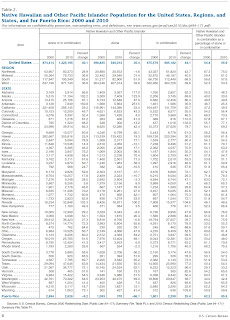We consistently hear of folks coming to Hawaiʻi, but often overlook that many were/are out-migrating from Hawaiʻi.
And, the increased scale of migration between Hawaiʻi and California and other parts of the continent may have started with us to them, rather than the reverse.
There is historical evidence suggesting that Hawaiians began moving to the US mainland as early as the late-1700s for economic survival.
As early as 1811, Hudson’s Bay Company (HBC) had already hired twelve Hawaiians on three year contracts to work for them in the Pacific Northwest. By 1824, HBC employed thirty-five Hawaiians west of the Rocky Mountains.
The number of Hawaiians working as contract laborers for the Hudson’s Bay Company steadily grew. The large number of Hawaiian workers in the village at Fort Vancouver led to the name "Kanaka Town" in the early 1850s - "Kanaka" is the word for "person" in the Native Hawaiian language.
Historians suggest “that young Hawaiian males left Hawai'i as workers on whaling ships and traveled to China, Europe, Mexico, and the U.S. mainland. In addition, many ventured into the Pacific Northwest territory, worked in the fur trade, and ended up settling in those areas.” (pbs-org)
In 1839, John Sutter brought a small group of native Hawaiians with him when he arrived in California. They worked for him and eventually intermarried with local Maidu families. They settled in the area of Vernon, which is now called Verona, where the Feather River flows into the Sacramento River in South Sutter County. (co-sutter-ca-us)
At the time of Sutter's arrival in California, the territory had a population of only 1,000 Europeans, in contrast with 30,000 Native Americans. It was at that point a part of Mexico and the governor, Juan Bautista Alvarado, granted him permission to settle.
In order to qualify for a land grant, Sutter became a Mexican citizen on August 29, 1840 after a year in the provincial settlement; the following year, on June 18, he received title to 48,827 acres and named his settlement New Helvetia, or "New Switzerland." Sutter employed Native Americans of the Miwok and Maidu tribes, Kanakas and Europeans at his compound, which he called Sutter's Fort.
In his memoirs, Sutter recalled the Hawaiians, using a name then common to describe Hawaiian workers, "I could not have settled the country without the aid of these Kanakas." They also built the first settlers' homes in Sacramento – grass shacks, or hale pili, made with California willow and bamboo.
“In the summer of 1865 some Hawaiian fishermen and their "wahine," who had sailed the placid Pacific in search of new realms for their nomad spirits, arrived in San Francisco bay only to discover that the cool fogs bred dire distress In lungs used to none but the fervid breezes of a tropic sea, so on they kept until, after a day and night of clear weather, they reached Vernon, a busy farming community on the banks of the Feather river.” (The San Francisco Call – March 26, 1911)
“It was here that San Mahalone and his companions built their huts and that today their children and grandchildren are peopling this colony this begun over 40-years ago, preserving their individuality and accumulating properties and competencies on the fertile lands of Sutter county.” (The San Francisco Call – March 26, 1911)
“Hawaiians also migrated to Yolo County, California to participate in the Gold Rush and created their own Kanaka Village. There is evidence that Hawaiians settled across California in the late-1800s and even intermarried with Native Americans. Many scholars speculate that Hawaiians migrated to the mainland in order to gain more economic opportunity and to flee from the dramatic Westernization that was changing the face of Hawai'i. (pbs-org)
In 1894, at Iosepa in Utah, “the colony of Hawaiians established in Skull Valley, Tooele county comes in with a splendid showing this year. This is all the more satisfactory when the difficulties which the colonists have had to contend with are considered.” (Deseret Evening News – December 22, 1894)
“Last spring a few members of the colony accepted the government invitation to return to the Sandwich Islands. Several of these have written back, expressing the wish that they were here, and declaring an intention to return to the colony as soon as practical.” (Deseret Evening News – December 22, 1894)
The Hawaiians' legacy can be seen today in the places named with Hawaiian words. They include Kanaka, Owyhee (an old Hawaiian name for Hawaii) and Kamai (named after the Hawaiian Kama Kamai): the Kanaka Glade in Mendocino County, California; Kanaka Creek in Sierra County, California; Kanaka Bars in Trinity County, California; Kanaka Flats in Jacksonville, Oregon; Kanaka Gulch, Oregon; Owyhee River in southeastern Oregon; and Kamai Point, British Columbia.
Of course, this summary only highlights some of the early outmigration of Hawaiians from Hawaiʻi. Recent decades has seen a flurry of movement of Hawaiians (and others) from Hawaiʻi to the continent. (Some areas on the continent show over 100% increases decade-by-decade in the number of Hawaiians living there.)
In the 2010 US Census, of all respondents who reported Native Hawaiian and Other Pacific Islander alone or in combination, 71-percent lived in the West, 16-percent lived in the South, 7-percent lived in the Northeast and 6-percent lived in the Midwest.
Hawaiʻi was home to 29% in the 2010 Census. Over half (52 percent) of the Native Hawaiian and Other Pacific Islander alone or in combination population lived in just two states, Hawaii (356,000) and California (286,000.)
The image shows a chart of the distribution of Native Hawaiians as reported in the 2010 Census. In addition, I have added additional images in a folder of like name in the Photos section on my Facebook and Google+ pages.
Follow Peter T Young on Facebook
Follow Peter T Young on Google+
© 2013 Hoʻokuleana LLC

No comments:
Post a Comment